| Giuseppe Garibaldi | |
|---|---|
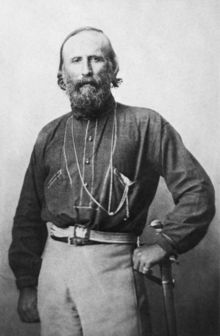 Giuseppe Garibaldi in 1861 | |
| Born | July 4, 1807 Nice, First French Empire |
| Died | June 2, 1882 (aged 74) Caprera, Kingdom of Italy |
| Monuments | A statue of Garibaldi pointing at the Vatican City on Janiculum in Rome, Italy Garibaldi Memorial, Staten Island, New York Garibaldi Monument in Taganrog, Russia A bust of Garibaldi outside the entrance to the old Supreme Court Chamber in the U.S. Capitol Building in Washington, D.C. Museo Nacional Casa Garibaldi, in Montevideo, Uruguay, Monumento a Giuseppe Garibaldi, Buenos Aires, Argentina |
| Organization | La Giovine Italia ("Young Italy") Carbonari |
| Influenced by | Giuseppe Mazzini |
| Influenced | Jessie White Mario Subhas Chandra Bose Georgios Grivas |
| Political movement | Il Risorgimento (Unification of Italy) |
Giuseppe Garibaldi (Italian pronunciation: [dʒuˈzɛppe ɡariˈbaldi] (July 4, 1807 – June 2, 1882) was an Italian military and political figure. In his twenties, he joined the Carbonari Italian patriot revolutionaries, and fled Italy after a failed insurrection. Garibaldi took part in the War of the Farrapos and the Uruguayan Civil War leading the Italian Legion, and afterward returned to Italy as a commander in the conflicts of the Risorgimento. He has been dubbed the "Hero of the Two Worlds" in tribute to his military expeditions in both South America and Europe.[1] He is considered an Italian national hero.
Early years
Giuseppe Garibaldi was born on July 4, 1807 in Nice (Italian: Nizza), which at the time was the capital of the French department of Alpes-Maritimes, before it was returned to the House of Savoy, the rulers of the Kingdom of Sardinia, in 1814 following Napoleon's defeat. In 1860, however, the Savoys returned the city to France (an action Garibaldi opposed), to get French aid in Italy's unification wars. Garibaldi's family's involvement in coastal trade drew him to a life at sea. He participated actively in the community of the Nizzardo Italians and was certified in 1832 as a merchant marine captain. An influential day in Garibaldi's life came in April 1833, in Taganrog, Russia where he moored for ten days with the schooner Clorinda and a shipment of oranges. In a seaport inn, he met Giovanni Battista Cuneo from Oneglia, a political immigrant from Italy and member of the secret movement La Giovine Italia ("Young Italy"), founded by Giuseppe Mazzini, an impassioned proponent of Italian unification as a liberal republic through political and social reforms. Garibaldi joined the society, and took an oath dedicating his life to the struggle to liberate his homeland from Austrian dominance.
In Geneva in November 1833, Garibaldi met Giuseppe Mazzini, starting a relationship that later became troublesome. He joined the Carbonari revolutionary association, and in February 1834 participated in a failed Mazzinian insurrection in Piedmont. A Genoese court sentenced him to death in absentia, and he fled to Marseilles.
South American adventures
Garibaldi first sailed to Tunisia, before eventually finding his way to Brazil. There he took up the cause of independence of the Republic of Rio Grande do Sul (the former Brazilian province of São Pedro do Rio Grande do Sul), joining the gaucho rebels known as the farrapos (tatters) against the newly independent Brazilian nation (see War of Tatters). During this war he met a woman, Ana Ribeiro da Silva (best known as "Anita"), when the Tatters Army tried to proclaim another republic in the Brazilian province of Santa Catarina. In October 1839, Anita joined Garibaldi on his ship, the Rio Pardo. A month later, she fought at her lover's side at the battles of Imbituba and Laguna.
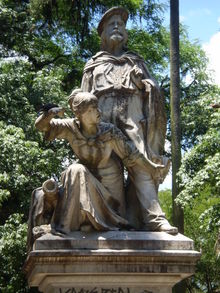
In 1842, Garibaldi took command of the Uruguayan fleet and raised an "Italian Legion" for the Uruguayan Civil War. He aligned with the liberal coalition of Uruguayan Colorados of Fructuoso Rivera and Argentine Unitarios (with substantive support of France and United Kingdom) against the conservative forces of former Uruguayan president Manuel Oribe's Blancos and Argentine Federales under the rule of Buenos Aires caudillo Juan Manuel de Rosas. The Legion adopted a black flag that represented Italy in mourning, with a volcano at the center that symbolized the dormant power in their homeland. Though there is no contemporary mention of them, popular history asserts that it was in Uruguay that the legion first wore the red shirts, said to have been obtained from a factory in Montevideo that had intended to export them to the slaughterhouses of Argentina. It became the symbol of Garibaldi and his followers. Between 1842 and 1848, Garibaldi defended Montevideo against forces led by Oribe. In 1845, he managed to occupy Colonia del Sacramento and Isla Martín García, and led the controversial sack of Gualeguaychú. Adopting skillful guerrilla tactics, he achieved two celebrated victories in the battles of Cerro and San Antonio del Santo in 1846.
The fate of his homeland, however, continued to concern Garibaldi. The election of Pope Pius IX in 1846 caused a sensation among Italian patriots, both at home and in exile. When news of the Pope's initial reforms (which seemed to identify him as the liberal pope prophesied by Vincenzo Gioberti, who later led the unification of Italy) reached Montevideo, Garibaldi wrote the following letter:
If these hands, used to fighting, would be acceptable to His Holiness, we most thankfully dedicate them to the service of him who deserves so well of the Church and of the fatherland. Joyful indeed shall we and our companions in whose name we speak be, if we may be allowed to shed our blood in defence of Pius IX's work of redemption—(October 12, 1847)[2]
Also Mazzini, from his exile, applauded the first reforms of Pius IX. In 1847, Garibaldi offered the apostolic nuncio at Rio de Janeiro, Bedini, the service of his Italian Legion for the liberation of the peninsula. News of the outbreak of revolution in Palermo in January 1848 and revolutionary agitation elsewhere in Italy encouraged Garibaldi to lead some 60 members of his legion home.
Return to Italy and second exile
After the crushing Piedmontese defeat at Novara (March 23, 1849), Garibaldi moved to Rome to support the Republic recently proclaimed in the Papal States, but a French force sent by Louis Napoleon (the future Napoleon III) threatened to topple it. At Mazzini's urging, Garibaldi took command of the defence of Rome. In fighting near Velletri, Achille Cantoni saved his life. After Cantoni's death, during the Battle of Mentana, Garibaldi wrote the novel Cantoni il volontario.
On April 30, 1849 the Republican army, under Garibaldi's command, defeated a numerically far superior French army. Subsequently, French reinforcements arrived, and the siege of Rome began on June 1. Despite the resistance of the Republican army, the French prevailed on June 29. On June 30 the Roman Assembly met and debated three options: surrender, continue fighting in the streets, or retreat from Rome to continue resistance from the Apennine mountains. Garibaldi made a speech favoring the third option and then said: Dovunque saremo, colà sarà Roma.[3] (Wherever we may be, there will be Rome).
A truce was negotiated on July 1, and on July 2 Garibaldi withdrew from Rome with 4,000 troops. The French Army entered Rome on July 3 and reestablished the Holy See's temporal power. Garibaldi and his forces, hunted by Austrian, French, Spanish, and Neapolitan troops, fled to the north with the intention to reach Venice, where the Venetians were still resisting the Austrian siege. After an epic march, Garibaldi took momentary refuge in San Marino, with only 250 men still following him. Anita, who was carrying their fifth child, died near Comacchio during the retreat.
America and the Pacific
Garibaldi eventually managed to reach Portovenere, near La Spezia, but the Piedmontese government forced him to emigrate again.
He went to Tangier, where he stayed with Francesco Carpanetto, a wealthy Italian merchant. Carpanetto suggested that he and some of his associates would finance the purchase of a merchant ship, which Garibaldi would command. Garibaldi agreed, feeling that his political goals were for the moment unreachable, and he could at least earn his own living.[4]
The ship was to be purchased in the United States, so Garibaldi went to New York, arriving on 30 July 1850. There he stayed with various Italian friends, including some exiled revolutionaries. However, funds for the purchase of a ship were lacking.
The inventor Antonio Meucci employed Garibaldi in his candle factory on Staten Island.[5] The cottage on Staten Island where he stayed is listed on the U.S. National Register of Historic Places and is preserved as the Garibaldi Memorial.
Garibaldi was not satisfied with this. In April 1851 he left New York with his friend Carpanetto for Central America, where Carpanetto was establishing business operations. They went first to Nicaragua, and then to other parts of the region. Garibaldi accompanied Carpanetto as a companion, not a business partner, and used the name "Giuseppe Pane."[4]
Carponetto went on to Lima, Peru, where a ship-load of his goods was due, arriving late in 1851 with Garibaldi. En route, Garibaldi called on Andean revolutionary heroine Manuela Sáenz.
At Lima, Garibaldi was generally welcomed. A local Italian merchant, Pietro Denegri, gave him command of his ship Carmen for a trading voyage across the Pacific. Garibaldi took the Carmen to the Chincha Islands for a load of guano. Then on 10 January 1852, he sailed from Peru for Canton, China, arriving in April.[4]
After side trips to Amoy and Manila, Garibaldi brought the Carmen back to Peru via the Indian Ocean and the South Pacific, passing clear around the south coast of Australia. He visited Three Hummocks Island in Bass Strait.[4]
Garibaldi then took the Carmen on a second voyage: to the United States via Cape Horn with copper from Chile, and also wool. Garibaldi arrived in Boston, and went on to New York. There he received a hostile letter from Denegri, and resigned his command.[4]
Another Italian, Captain Figari, had just come to the U.S. to buy a ship. He hired Garibaldi to take his ship to Europe. Figari and Garibaldi bought the Commonwealth in Baltimore, and Garibaldi left New York for the last time in November 1853.[5] He sailed the Commonwealth to London and then to Newcastle on the River Tyne for coal.[4]
Tyneside
Commonwealth arrived on March 21, 1854. Garibaldi, already a popular figure on Tyneside, was welcomed enthusiastically by local workingmen, although the Newcastle Courant reported that he refused an invitation to dine with dignitaries in the city. He stayed in South Shields on Tyneside for over a month, departing at the end of April 1854. During his stay, he was presented with an inscribed sword, which his grandson later carried as a volunteer in British service in the Boer War.[6] He then sailed to Genoa, where his five years of exile ended on 10 May 1854.[4]
Second Italian War of Independence
With his volunteers, he won victories over the Austrians at Varese, Como, and other places.
Garibaldi was however very displeased as his home city of Nice (Nizza in Italian) was surrendered to the French, in return for crucial military assistance. In April 1860, as deputy for Nice in the Piedmontese parliament at Turin, he vehemently attacked Cavour for ceding Nice and the County of Nice (Nizzardo) to Louis Napoleon, Emperor of France. In the following years Garibaldi (with other passionate Nizzardo Italians) promoted the Irredentism of his Nizza, even with riots (in 1872).
Campaign of 1860
On January 24, 1860, Garibaldi married an 18-year-old Lombard noblewoman, Giuseppina Raimondi. Immediately after the wedding ceremony, however, she informed him that she was pregnant with another man's child and Garibaldi left her the same day.[7]
At the beginning of April 1860, uprisings in Messina and Palermo in the independent and peaceful Kingdom of the Two Sicilies provided Garibaldi with an opportunity. He gathered about a thousand volunteers (practically all northern Italians, and called i Mille (the Thousand), or, as popularly known, the Redshirts) in two ships named Piemonte and Lombardo, left from Genoa on May 5 in the evening and landed at Marsala, on the westernmost point of Sicily, on May 11.
Swelling the ranks of his army with scattered bands of local rebels, Garibaldi led 800 volunteers to victory over an enemy force of 1500 on the hill of Calatafimi on May 15. He used the counter-intuitive tactic of an uphill bayonet charge. He saw that the hill the enemy had taken position on was terraced, and the terraces would give shelter to his advancing men. Though small by comparison with the coming clashes at Palermo, Milazzo and Volturno, this battle was decisive in terms of establishing Garibaldi's power in the island. An apocryphal but realistic story had him say to his lieutenant Nino Bixio, Qui si fa l'Italia o si muore, that is, Here we either make Italy, or we die. In reality, the Neapolitan forces were ill guided, and most of its higher officers had been bought out. The next day, he declared himself dictator of Sicily in the name of Victor Emmanuel II of Italy. He advanced to Palermo, the capital of the island, and launched a siege on May 27. He had the support of many inhabitants, who rose up against the garrison, but before they could take the city , reinforcements arrived and bombarded the city nearly to ruins. At this time, a British admiral intervened and facilitated an armistice, by which the Neapolitan royal troops and warships surrendered the city and departed.
Garibaldi had won a single victory. He gained worldwide renown and the adulation of Italians. Faith in his prowess was so strong that doubt, confusion, and dismay seized even the Neapolitan court. Six weeks later, he marched against Messina in the east of the island, winning a ferocious and difficult battle at Milazzo. By the end of July, only the citadel resisted.
Having conquered Sicily, he crossed the Strait of Messina with help from the British Royal Navy, and marched north. Garibaldi's progress was met with more celebration than resistance, and on September 7 he entered the capital city of Naples, by train. Despite taking Naples, however, he had not to this point defeated the Neapolitan army. Garibaldi's volunteer army of 24,000 was not able to defeat conclusively the reorganized Neapolitan army (about 25,000 men) on September 30 at the Battle of Volturno. This was the largest battle he ever fought, but its outcome was effectively decided by the arrival of the Piedmontese Army. Following this, Garibaldi's plans to march on to Rome were jeopardized by the Piedmontese, technically his ally but unwilling to risk war with France, whose army protected the Pope. (The Piedmontese themselves had conquered most of the Pope's territories in their march south to meet Garibaldi, but they had deliberately avoided Rome, his capital.) Garibaldi chose to hand over all his territorial gains in the south to the Piedmontese and withdrew to Caprera and temporary retirement. Some modern historians consider the handover of his gains to the Piedmontese as a political defeat, but he seemed willing to see Italian unity brought about under the Piedmontese crown. The meeting at Teano between Garibaldi and Victor Emmanuel II is the most important event in modern Italian history, but is so shrouded in controversy that even the exact site where it took place is in doubt.
Aftermath
Garibaldi deeply disliked the Sardinian Prime Minister, Camillo Benso, conte di Cavour. To an extent, he simply mistrusted Cavour's pragmatism and realpolitik, but he also bore a personal grudge for trading away his home city of Nice to the French the previous year. On the other hand, he felt attracted toward the Piedmontese monarch, who in his opinion had been chosen by Providence for the liberation of Italy. In his famous meeting with Victor Emmanuel II at Teano on October 26, 1860, Garibaldi greeted him as King of Italy and shook his hand. Garibaldi rode into Naples at the king's side on November 7, then retired to the rocky island of Caprera, refusing to accept any reward for his services.
On October 5 Garibaldi set up the International Legion bringing together different national divisions of French, Poles, Swiss, German and other nationalities, with a view not just of finishing the liberation of Italy, but also of their homelands. With the motto "Free from the Alps to the Adriatic," the unification movement set its gaze on Rome and Venice. Mazzini was discontented with the perpetuation of monarchial government, and continued to agitate for a republic. Garibaldi, frustrated at inaction by the king, and bristling over perceived snubs, organized a new venture. This time, he intended to take on the Papal States.
At the outbreak of the American Civil War (in 1861), Garibaldi volunteered his services to President Abraham Lincoln. Garibaldi was offered a Major General's commission in the U. S. Army through the letter from Secretary of State William H. Seward to H. S. Sanford, the U. S. Minister at Brussels, July 17, 1861.[8] On September 18, 1861, Sanford sent the following reply to Seward:
He [Garibaldi] said that the only way in which he could render service, as he ardently desired to do, to the cause of the United States, was as Commander-in-chief of its forces, that he would only go as such, and with the additional contingent power—to be governed by events—of declaring the abolition of slavery; that he would be of little use without the first, and without the second it would appear like a civil war in which the world at large could have little interest or sympathy.[9]
According to Italian historian Petacco, "Garibaldi was ready to accept Lincoln's 1862 offer but on one condition: that the war's objective be declared as the abolition of slavery. But at that stage Lincoln was unwilling to make such a statement lest he worsen an agricultural crisis."[10] On August 6, 1863, after the Emancipation Proclamation had been issued, Garibaldi wrote to Lincoln: "Posterity will call you the great emancipator, a more enviable title than any crown could be, and greater than any merely mundane treasure."[11]
Expedition against Rome
A challenge against the Pope's temporal domain was viewed with great distrust by Catholics around the world, and the French emperor Napoleon III had guaranteed the independence of Rome from Italy by stationing a French garrison in Rome. Victor Emmanuel was wary of the international repercussions of attacking the Papal States, and discouraged his subjects from participating in revolutionary ventures with such intentions. Nonetheless, Garibaldi believed he had the secret support of his government.
In June 1862, he sailed from Genoa and landed at Palermo, seeking to gather volunteers for the impending campaign under the slogan Roma o Morte (Rome or Death). An enthusiastic party quickly joined him, and he turned for Messina, hoping to cross to the mainland there. When he arrived, he had a force of some two thousand, but the garrison proved loyal to the king's instructions and barred his passage. They turned south and set sail from Catania, where Garibaldi declared that he would enter Rome as a victor or perish beneath its walls. He landed at Melito on August 14, and marched at once into the Calabrian mountains.
Far from supporting this endeavor, the Italian government was quite disapproving. General Enrico Cialdini dispatched a division of the regular army, under Colonel Pallavicino, against the volunteer bands. On August 28 the two forces met in the rugged Aspromonte. One of the regulars fired a chance shot, and several volleys followed, killing a few of the volunteers. The fighting ended quickly, as Garibaldi forbade his men to return fire on fellow subjects of the Kingdom of Italy. Many of the volunteers were taken prisoner, including Garibaldi, who had been wounded by a shot in the foot.
This episode gave birth to a famous Italian nursery rhyme, still known by boys and girls all over the country: Garibaldi fu ferito ("Garibaldi was wounded").
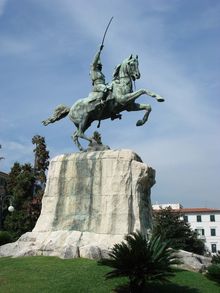
A government steamer took him to Varignano, a prison near La Spezia, where he was held in a sort of honorable imprisonment, and was compelled to undergo a tedious and painful operation for the healing of his wound. His venture had failed, but he was at least consoled by Europe's sympathy and continued interest. After being restored to health, he was released and allowed to return to Caprera.
In 1864 he visited London, where his presence was received with enthusiasm by the population.[12] He met the British prime minister Viscount Palmerston, as well as other revolutionaries then living in exile in the city. At that time, his ambitious international project included the liberation of a range of occupied nations, such as Croatia, Greece, Hungary, but none of them turned into reality.
Final struggle with Austria, and other adventures
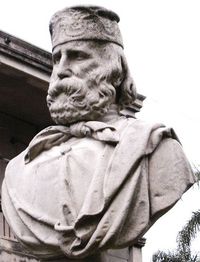
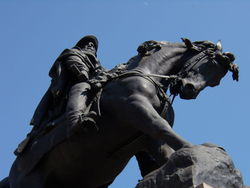
Garibaldi took up arms again in 1866, this time with the full support of the Italian government. The Austro-Prussian War had broken out, and Italy had allied with Prussia against Austria-Hungary in the hope of taking Venetia from Austrian rule (Third Italian War of Independence). Garibaldi gathered again his Hunters of the Alps, now some 40,000 strong, and led them into the Trentino. He defeated the Austrians at Bezzecca (thus securing the only Italian victory in that war) and made for Trento.
The Italian regular forces were defeated at Lissa on the sea, and made little progress on land after the disaster of Custoza. An armistice was signed, by which Austria ceded Venetia to Italy, but this result was largely due to Prussia's successes on the northern front. Garibaldi's advance through Trentino was for nought and he was ordered to stop his advance to Trento. Garibaldi answered with a short telegram from the main square of Bezzecca with the famous motto: Obbedisco! ("I obey!") .
After the war, Garibaldi led a political party that agitated for the capture of Rome, the peninsula's ancient capital. In 1867, he again marched on the city, but the Papal army, supported by a French auxiliary force, proved a match for his badly armed volunteers. He was shot and wounded in the leg in the Battle of Mentana, and had to withdraw out of the Papal territory. The Italian government again imprisoned and held him for some time, after which he again returned to Caprera.
In the same year, Garibaldi sought international support for altogether eliminating the papacy. At an 1867 congress in Geneva he proposed: "The papacy, being the most harmful of all secret societies, ought to be abolished."[13]
When the Franco-Prussian War broke out in July 1870, Italian public opinion heavily favored the Prussians, and many Italians attempted to sign up as volunteers at the Prussian embassy in Florence. After the French garrison was recalled from Rome, the Italian Army captured the Papal States without Garibaldi's assistance. Following the wartime collapse of the Second French Empire at the battle of Sedan, Garibaldi, undaunted by the recent hostility shown to him by the men of Napoleon III, switched his support to the newly declared French Third Republic. On 7 September 1870, within three days of the revolution of 4 September in Paris, he wrote to the Movimento of Genoa:
Yesterday I said to you: war to the death to Bonaparte. Today I say to you: rescue the French Republic by every means.[14]
Subsequently, Garibaldi went to France and assumed command of the Army of the Vosges, an army of volunteers that was never defeated by the Prussians.

Death
Despite being elected again to the Italian parliament, Garibaldi spent much of his late years in Caprera. He however supported an ambitious project of land reclamation in the marshy areas of southern Lazio.
In 1879 he founded the "League of Democracy," which advocated universal suffrage, abolition of ecclesiastical property, emancipation of women, and maintenance of a standing army. Ill and confined to a bed by arthritis, he made trips to Calabria and Sicily. In 1880 he married Francesca Armosino, with whom he had previously had three children.
On his deathbed, Garibaldi asked that his bed be moved to where he could gaze at the emerald and sapphire sea. Upon his death on June 2, 1882 at the age of almost 75, his wishes for a simple funeral and cremation were not respected. He is buried on his farm on the island of Caprera alongside his last wife and some of his children.[15]
Writings
Garibaldi wrote at least two novels, characterized by an anti-clerical tone:
- Clelia or Il governo dei preti (1867) english translation, t. 1 english translation, t. 2
- Cantoni il volontario (1870)
- I Mille (1873)
He also wrote non-fiction:
- Autobiography[16] (v. 1 1807-1849)
- Memoirs,[17] co-authored by Alexandre Dumas
- A translation of his memoirs is The life of Garibaldi written by himself (New York: Barnes, 1859)
Legacy
Garibaldi's popularity, his skill at rousing the common people, and his military exploits are all credited with making the unification of Italy possible. He also served as a global exemplar of mid-19th century revolutionary nationalism and liberalism. But following the liberation of southern Italy from the Neapolitan monarchy, Garibaldi chose to sacrifice his liberal republican principles for the sake of unification.
Garibaldi subscribed to the anti-clericalism common among Latin liberals, and did much to circumscribe the temporal power of the Papacy. His personal religious convictions are unclear to historians—in 1882 he wrote "Man created God, not God created Man," yet in his autobiography he is quoted as saying "I am a Christian, and I speak to Christians - I am a true Christian, and I speak to true Christians. I love and venerate the religion of Christ, because Christ came into the world to deliver humanity from slavery..." and "you have the duty to educate the people- educate the people- educate them to be Christians- educate them to be Italians... Viva Italia! Viva Christianity!"[citation needed]

An active Freemason, Garibaldi had little use for rituals, but thought of masonry as a network to unite progressive men as brothers both within nations and as members of a global community. He eventually was elected Grand Master of the Grand Orient of Italy.[18]
Giuseppe Garibaldi died at Caprera in 1882, where he was interred. Five ships of the Italian Navy have been named after him, among which a World War II cruiser and the former flagship, the aircraft carrier Giuseppe Garibaldi.
Statues of his likeness, as well as the handshake of Teano, stand in many Italian squares, and in other countries around the world. On the top of the Janiculum hill in Rome, there is a statue of Garibaldi on horse-back. His face was originally turned in the direction of the Vatican (an allusion[citation needed] to his ambition to conquer the Papal States), but after the Lateran Treaty in 1929 the orientation of the statue was changed upon request of the Vatican. A bust of Giuseppe Garibaldi is prominently placed outside the entrance to the old Supreme Court Chamber in the U.S. Capitol Building in Washington, DC, a gift from members of the Italian Society of Washington. Many theatres in Sicily take their name from him and are named Garibaldi Theatre.
In a recent book review in The New Yorker (July 9 & 16, 2007) of a Garibaldi biography, Tim Parks cites the eminent English historian, A.J.P. Taylor, as saying, "Garibaldi is the only wholly admirable figure in modern history."[1]
English football team Nottingham Forest designed their home kit after the uniform worn by Garibaldi and his men and have worn a variation of this design since being founded in 1865. A school in Mansfield, Nottinghamshire was also named after him. The Garibaldi biscuit was named after him, as was a style of beard. The Giuseppe Garibaldi Trophy has been awarded annually since 2007 within the Six Nations rugby union framework to the victor of the match between France and Italy, in the memory of Garibaldi.
Garibaldi, along with Giuseppe Mazzini and other Europeans supported the creation of a European federation. Many Europeans expected a unified Germany to become a European and world leader and to champion humanitarian policies. This is demonstrated in the following letter written by Giuseppe Garibaldi to Karl Blind on 10 April 1865.
The progress of humanity seems to have come to a halt, and you with your superior intelligence will know why. The reason is that the world lacks a nation which possesses true leadership. Such leadership, of course, is required not to dominate other peoples, but to lead them along the path of duty, to lead them toward the brotherhood of nations where all the barriers erected by egoism will be destroyed. We need the kind of leadership which, in the true tradition of medieval chivalry, would devote itself to redressing wrongs, supporting the weak, sacrificing momentary gains and material advantage for the much finer and more satisfying achievement of relieving the suffering of our fellow men. We need a nation courageous enough to give us a lead in this direction. It would rally to its cause all those who are suffering wrong or who aspire to a better life, and all those who are now enduring foreign oppression.
This role of world leadership, left vacant as things are today, might well be occupied by the German nation. You Germans, with your grave and philosophic character, might well be the ones who could win the confidence of others and guarantee the future stability of the international community. Let us hope, then, that you can use your energy to overcome your moth-eaten thirty tyrants of the various German states. Let us hope that in the center of Europe you can then make a unified nation out of your fifty millions. All the rest of us would eagerly and joyfully follow you.[19]
http://encyclopedia.thefreedictionary.com/p/Garibaldi,%20Giuseppe

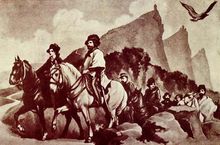


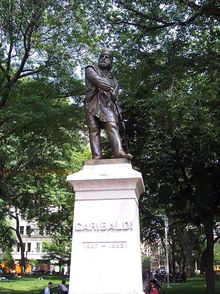
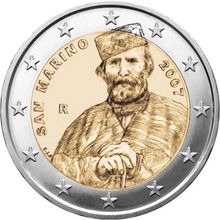
No comments:
Post a Comment